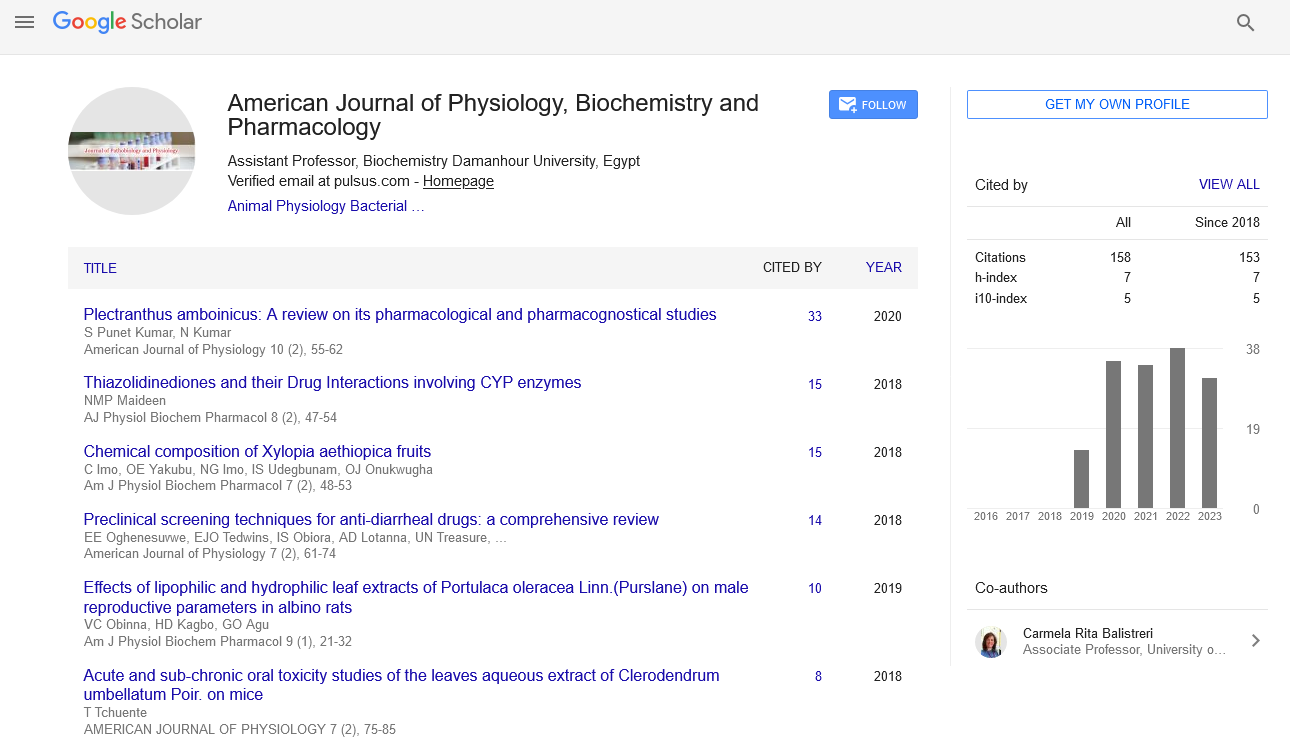Opinion - American Journal of Physiology, Biochemistry and Pharmacology (2023)
Exploring the Role of Therapeutic Strategies in Pharmacology: Applications and Limitations
Qen Yiyuo*Qen Yiyuo, Department of Pharmacology, Nankai University, Tianjin, China, Email: Qyiyuo56@gmail.com
Received: 26-May-2023, Manuscript No. AJPBP -23-101287; Editor assigned: 29-May-2023, Pre QC No. AJPBP -23-101287(PQ); Reviewed: 12-Jun-2023, QC No. AJPBP -23-101287; Revised: 19-Jun-2023, Manuscript No. AJPBP -23-101287(R); Published: 26-Jun-2023
Description
Pharmacology, the scientific study of drugs and their effects on living organisms, plays a critical role in modern medicine. With its interdisciplinary nature, pharmacology combines aspects of biology, chemistry, physiology, and medicine to uncover the complexities of how drugs interact with the human body. This article discusses about the fascinating world of pharmacology, exploring its principles, mechanisms, and impact on healthcare [1-2].
Pharmacology includes molecular and cellular mechanisms, organ/system mechanisms, signal transduction/cellular communication, molecular diagnostics, interactions, chemical biology, therapy, medical applications, and ant pathogenic capabilities. It also includes drug composition and properties, functions, sources, synthesis, and drug design [3].
Understanding pharmacology
At its core, pharmacology investigates the properties and actions of drugs, encompassing various aspects such as their composition, preparation, and mode of action. Researchers in this field strive to comprehend how drugs interact with living systems, from the molecular level to entire organisms. Pharmacologists study drug absorption, distribution, metabolism, and excretion—commonly referred to as ADME—to assess how medications are processed within the body.
Although the terms are commonly misunderstood, pharmacology and pharmacy are not interchangeable. A biomedical discipline called pharmacology is concerned with the investigation, identification, and characterization of chemicals that have biologbiological effects as well as the clarification of how cells and organisms work in connection to these chemicals [4].
Pharmacodynamics and pharmacokinetics
Pharmacodynamics focuses on understanding how drugs produce their effects on the body, elucidating the mechanisms by which they bind to specific receptors and alter cellular function. By studying pharmacodynamics, researchers gain insights into a drug’s potency, efficacy, and potential side effects.
Pharmacokinetics, on the other hand, investigates the processes that influence drug movement throughout the body. This field examines drug absorption, distribution within tissues, and metabolism by enzymes, and elimination from the body. Understanding pharmacokinetics helps in determining the optimal dosage, frequency, and route of administration for a particular drug [5].
Applications in healthcare
Pharmacology has immense significance in healthcare, as it forms the basis for developing new drugs, optimizing treatment regimens, and ensuring patient safety. Pharmaceutical companies rely on pharmacological research to design and test new medications, aiming to improve therapeutic options for various conditions. Additionally, pharmacological studies play a vital role in assessing drug interactions, evaluating potential adverse effects, and enhancing drug delivery systems.
Personalized medicine, a burgeoning field within pharmacology, tailors treatments to an individual’s genetic makeup, allowing for more effective and precise therapies. Pharmacogenomics, a subfield of pharmacology, examines how genetic variations influence an individual’s response to drugs, enabling healthcare professionals to select medications that are more likely to be effective and safe for each patient [6-7].
Limitations
As technology advances, pharmacology continues to evolve and expand its horizons. The development of high-throughput screening techniques, computational modelling, and advanced imaging technologies has accelerated the discovery of novel drug targets and improved the understanding of drug action. Furthermore, the integration of artificial intelligence and machine learning algorithms has enabled the identification of new drug candidates and the prediction of drug responses [8].
Pharmacology remains at the forefront of medical advancements, playing a vital role in the development and optimization of therapeutic interventions. Through its interdisciplinary approach, pharmacology continues to unravel the complexities of drug action, helping researchers and healthcare professionals provide better treatment options for patients. The field of pharmacology holds the of revolutionizing medicine and improving healthcare outcomes for individuals worldwide.
References
- Taka K, Avdeel A. Interlaboratory study of log {ce: Inline-formula} P {/ce: inline-formula} determination by shake-flask and potentiometric methods. J Pharm Biomed Anal 1996;14(11):1405-1413.
- Rang HP. The receptor concept: Pharmacology's big idea. Br J Pharmacol 2006 47(S1):S9-16.
- Mueller C, Schur C, O'Connell J. Prescription drug spending: the impact of age and chronic disease status. Am J Public Health 1997; 87(10):1626-1629.
- Minutoli L, Micali A, Pisani A, Puzzolo D, Bitto A, Rinaldi M, et al. Flavocoxid Protects Against Cadmium-Induced Disruption of the Blood-Testis Barrier and Improves Testicular Damage and Germ Cell Impairment in Mice. Toxicol Sci 2015; 148(1):311-329.
- Alexander SP, Fabbro D, Kelly E, Mathie A, Peters JA, Veale EL, et al. The concise guide to pharmacology 2021/22: Catalytic receptors Br J Pharmacol 2021; 178:S264-312
- Boike L, Henning NJ, Nomura DK. Advances in covalent drug discovery. Nat Rev Drug Discov 2022;25:1-8.
- Robert WB, Samuel MA, Craig WC. Kinetics of materials. John Wiley and Sons Incorporated, 2005.
- Foote J, Winter G. Antibody framework residues affecting the conformation of the hypervariable loops. J Mol Biol 1992;224(2):487-499.
Copyright: © 2023 The Authors. This is an open access article under the terms of the Creative Commons Attribution NonCommercial ShareAlike 4.0 (https://creativecommons.org/licenses/by-nc-sa/4.0/) This is an open access article distributed under the terms of the Creative Commons Attribution License, which permits unrestricted use, distribution, and reproduction in any medium, provided the original work is properly cited.






